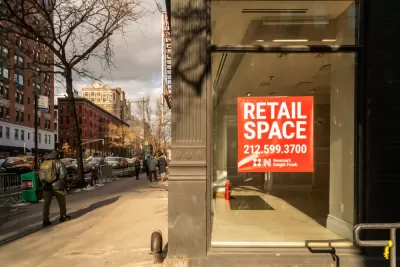With demand for housing growing and for physical storefronts waning, do the restrictions imposed by ground-floor retail zoning still make sense?

Zoning requiring ground-floor retail began as a way to activate street-level spaces and prevent sidewalks from becoming drab corridors marked by low-traffic uses. But as the demand for physical retail diminishes, David Morley, writing in the American Planning Association blog, comments that cities will need to adjust retail zoning to reflect that changing demand.
Citing Tom Smith’s article "Activating Ground Floors in Mixed-Use Buildings After COVID," Morley writes, “In Smith's view, there are only two logical responses: expanding permissible uses and downsizing retail-only corridors and districts.” Smith argues that cities could expand permitted uses by allowing offices and small-scale, clean industrial uses that could replace traditional retail.
Smith also tackles housing. “Perhaps the only universal feature of active ground-floor use requirements is that street-fronting ground-floor residences are prohibited.” Yet with the housing crisis raging out of control, would permitting housing in some ground-floor spaces be such a bad thing? “As Smith points out, the alternative is likely a permanent abundance of vacant storefronts, which does nothing to support the businesses that remain.”
Around the country, cities and developers are rethinking the role of commercial real estate like retail and office space. Buildings that once housed massive malls, often conveniently located near major transportation corridors, are now being converted to housing and mixed-use developments.
FULL STORY: How Should We Zone for Post-Retail Streets?

Planetizen Federal Action Tracker
A weekly monitor of how Trump’s orders and actions are impacting planners and planning in America.

San Francisco's School District Spent $105M To Build Affordable Housing for Teachers — And That's Just the Beginning
SFUSD joins a growing list of school districts using their land holdings to address housing affordability challenges faced by their own employees.

The Tiny, Adorable $7,000 Car Turning Japan Onto EVs
The single seat Mibot charges from a regular plug as quickly as an iPad, and is about half the price of an average EV.

Austin's First Single Stair Apartment Building is Officially Underway
Eliminating the requirement for two staircases in multi-story residential buildings lets developers use smaller lots and more flexible designs to create denser housing.

Atlanta Bus System Redesign Will Nearly Triple Access
MARTA's Next Gen Bus Network will retool over 100 bus routes, expand frequent service.

Toronto Condo Sales Drop 75%
In two of Canada’s most expensive cities, more condos were built than ever — and sales are plummeting.
Urban Design for Planners 1: Software Tools
This six-course series explores essential urban design concepts using open source software and equips planners with the tools they need to participate fully in the urban design process.
Planning for Universal Design
Learn the tools for implementing Universal Design in planning regulations.
Smith Gee Studio
City of Charlotte
City of Camden Redevelopment Agency
City of Astoria
Transportation Research & Education Center (TREC) at Portland State University
US High Speed Rail Association
City of Camden Redevelopment Agency
Municipality of Princeton (NJ)





























